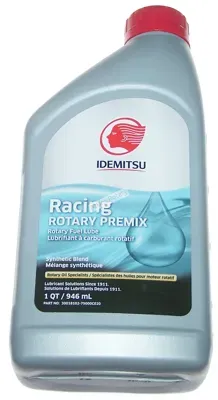The premix gas and oil rotary engine represents a unique marriage of engineering and performance, particularly known for its efficiency and spirited driving experience. This type of engine operates on a peculiar design pioneered by Felix Wankel, which requires a careful balance of fuel and lubricants to function optimally. By premixing oil with gasoline, rotary engines not only enhance lubrication but also help maintain engine health, particularly in models like the Mazda rotary engine. Wankel engine oil, specifically formulated for these systems, plays a crucial role in reducing friction and preventing wear on critical components. Understanding the intricacies of oil mixing, including the use of an effective oil-metering system rotary engines, is essential for anyone keen on maximizing the longevity and performance of their rotary-powered vehicle.
In the world of internal combustion engines, the term ‘premix fuel’ refers to the practice of combining gasoline with oil before use in the engine, especially vital for engines with a rotary design. This technique is closely associated with the Wankel engine, named after its inventor, which features a distinct triangular rotor that rotates within an elliptical casing. To prevent excessive wear on engine parts, particularly the apex seals, drivers often consider premix oil for rotary engines as a preventative measure. Additionally, rotary engines often utilize specialized oil-mixing systems that help optimize lubrication while adhering to emissions standards. For enthusiasts and racers alike, understanding how to effectively blend fuel and oil is crucial for maintaining the health and performance of their vehicles.
Understanding Rotary Engine Functionality
The rotary engine operates on a unique design where a triangular rotor spins within an oval housing. This design revolutionizes typical piston movements found in standard internal combustion engines. Instead of using pistons that slide up and down, the rotor’s apexes create seals with the housing walls. As it spins, the spaces between the rotor’s edges and the housing allow for the intake of mixed fuel and air, leading to combustion. This compact and efficient process represents the ingenuity behind Felix Wankel’s innovative engineering, although it has not been without complications.
Because of the unconventional mechanics of rotary engines, the lubrication needs are also different. The apex seals, crucial components of this system, can wear down quickly due to friction and heat. This is where premixing gas and oil becomes important. By ensuring a steady flow of oil mixed into the fuel, owners of rotary vehicles can mitigate the risk of seal damage and extend engine lifespan. Hence, understanding the basics of rotary engine functionality and proper lubrication practices is vital for enthusiasts and everyday drivers alike.
The Importance of Premixing Gas and Oil
In many cases, especially with older models and those subjected to high-stress conditions, premixing gas and oil becomes essential for maintaining engine health. As noted in the case of Mazda’s RX-7 and RX-8, these vehicles have faced challenges regarding oil delivery through their electronically-controlled oil-metering systems. Engineers had to balance the necessity for lubrication against emissions regulations, leading to a reduction in the amount of oil supplied. Consequently, drivers of these cars might find that premixing provides a safeguard against excessive wear and tear on crucial internal components.
Moreover, premixing is particularly advantageous in competitive settings, such as autocross or circuit racing. The intense conditions of racing create significant friction and heat, which standard oil-metering systems may struggle to manage efficiently. By premixing oil with gasoline, drivers can significantly reduce the likelihood of apex seal failure, thereby helping to ensure their rotary engine performs optimally under stress. Therefore, understanding when and how to effectively premix gas and oil is a core aspect of rotary engine maintenance.
Choosing the Right Oil for Rotary Engines
When it comes to selecting the proper oil for premixing with gasoline in rotary engines, not all types are created equal. Traditional engine oil is a poor choice, as it lacks the necessary properties to combine effectively with gasoline, leading to separation in the tank. This separation can compromise the consistency of lubrication, potentially resulting in costly engine damage. Instead, two-stroke motor oils, particularly those high-quality synthetics with JASO FC or FD ratings, are recommended due to their formulation for high-performance applications.
Brands specializing in rotary engine lubrication, such as Motul, Idemitsu, and Klotz, offer products designed specifically for the unique demands of Wankel engines. These oils are engineered to withstand higher temperatures and provide superior protection compared to standard oils. When mixing, the recommended ratio typically involves about 4 ounces of oil for every 10 gallons of gasoline, which balances performance with the need to maintain proper lubrication levels without impacting emissions negatively.
Potential Issues with Oil-Metering Systems
Oil-metering systems, designed to inject oil into the combustion chamber, have become a staple in modern rotary engines, yet they are not without their drawbacks. Many systems are prone to failure or inefficiencies that can lead to inadequate lubrication. For instance, the electronically-controlled oil-metering system first introduced in Mazda’s RX-7 had issues with ensuring proper oil flow, leading to engine wear. Consequently, some owners opted for oil-metering system deletes to manually manage their oil mixtures.
Given these potential pitfalls, the decision to premix gas and oil becomes crucial for rotary engine operators. This proactive approach ensures that the necessary amount of oil consistently reaches the apex seals, thereby protecting them from excessive friction. As rotary enthusiasts become more aware of the limitations inherent in existing oil-metering technologies, the trend towards premixing to safeguard engine longevity will likely continue to rise.
Benefits of Premixing for Competition Vehicles
For those participating in competitive motorsports or autocross events, the stress placed on a rotary engine transcends the typical operational conditions. The spikes in temperature and pressure during racing can exacerbate any weaknesses, particularly in areas like apex seals. Premixing gas and oil not only ensures those seals remain lubricated but also contributes to overall engine reliability during thrilling yet demanding driving experiences.
Additionally, premixing serves as a form of insurance policy against the nuanced complexities of rotary engine performance. Regardless of whether it’s a vintage Mazda model or a more recent incarnation, these engines share a legacy of oil-related issues. By adopting a premixing strategy, racers and performance drivers can focus on maximizing their vehicle’s potential without the constant worry of mechanical failure due to inadequate lubrication.
Understanding Wankel Engine Oil Requirements
The Wankel engine, known for its rotary design, has specific lubrication requirements that differ significantly from traditional engines. As this engine relies heavily on the proper functioning of apex seals, understanding the oil’s role in this system is essential for any owner. Maintenance practices often emphasize the differences in oil mixing ratios and types tailored for rotary engines to optimize their performance.
Rotary engine owners should be aware of the implications of using inappropriate oils. Oil meant for two-stroke lawn equipment, for example, is not suited for high-performance rotary applications due to additives that could harm plastic components. Therefore, selecting oils that meet the criteria set out by experts ensures that rotary engines operate smoothly, allowing for both daily use and spirited driving.
Fine-Tuning Oil Mixtures and Performance
Fine-tuning the oil mixture for rotary engines isn’t solely about achieving the right blend—it’s about enhancing performance. Understanding the specifics of your vehicle can lead to adjustments that maximize power output and maintain peak efficiency. For instance, a more concentrated blend may assist in racing conditions, where the engine is pushed to its limits.
Moreover, manufacturers like Mazda have released recommendations based on extensive testing of their models, which serve as a good baseline for drivers looking to adjust their oil-to-gas ratios. Coupled with this knowledge, rotary engine enthusiasts often share insights within community forums to develop the best practices for achieving optimal engine performance while preserving the longevity of critical components.
Environmental Considerations for Rotary Engines
As the world becomes increasingly focused on sustainability, the environmental impacts of rotary engines are coming into question. These engines are often scrutinized for their emissions, which can contribute to air pollution, especially at higher engine loads. This concern has led some engineers to focus on improving oil-metering systems to minimize the amount of oil mixed and thereby reduce emissions, but this can create challenges in maintaining engine health.
Therefore, premixing gas and oil can be a compromise between performance and environmental responsibility. By using high-quality, eco-conscious oils formulated for rotary engines, it’s possible to achieve lower emissions while still providing the necessary lubrication for optimal operation. Additionally, environmentally friendly practices can also mean selecting oils that adhere to low-emission standards, benefiting both the car owner and the planet.
Future Developments in Rotary Engine Technology
The future of rotary engine technology remains promising, with ongoing research aimed at resolving long-standing issues related to lubrication and emissions. Automakers are exploring new methods to enhance oil-metering systems and improve the efficiency of oil used in the combustion process. These advances could significantly reduce the need for manual premixing, making rotary engines more user-friendly and environmentally viable.
Innovations like alternative fuel options and more efficient combustion techniques are also being investigated. If successful, these technologies may lead to a new generation of rotary engines that retain the unique benefits of the Wankel design while overcoming its traditional drawbacks. As more enthusiasts and manufacturers invest in rotary technology, the landscape of rotary engines could evolve, confirming its place in the automotive future.
Frequently Asked Questions
Do I have to premix gas and oil for a Mazda rotary engine?
Yes, some Mazda rotary engines, especially models like the RX-7 and RX-8, benefit from premixing gas and oil. This helps ensure adequate lubrication for the apex seals and can extend engine life, particularly under stress or when using an oil-metering system that might not deliver enough oil.
What oil should I use for premixing in a Wankel engine?
For a Wankel engine, you should use high-quality two-stroke synthetic motor oil with a JASO rating of FC or FD. Avoid traditional engine oils as they do not mix well with gasoline. Brands like Idemitsu, Klotz, and Motul offer oils specifically formulated for rotary engines.
How do oil-metering systems work in rotary engines?
Oil-metering systems in rotary engines, such as those found in the 1989 Mazda RX-7, inject oil into the gasoline to lubricate the apex seals. However, these systems can sometimes under-deliver oil, making premixing a beneficial practice to ensure optimal engine operation.
What is the recommended premix ratio of oil to gasoline for rotary engines?
The general recommendation for premixing oil with gasoline in rotary engines like the RX-7 is about 4 ounces of oil per 10 gallons of fuel. This ratio ensures that the apex seals receive adequate lubrication without compromising performance.
Is premix oil for rotary engines different from regular engine oil?
Yes, premix oil for rotary engines is specifically formulated to mix well with gasoline and provide the necessary lubrication at high temperatures. Regular engine oils do not mix properly and can separate, leading to inadequate lubrication for the rotary engine.
What are the benefits of premixing gas and oil for rotary engines?
Premixing gas and oil for rotary engines can improve lubrication, reduce friction on apex seals, and extend engine life, especially in models with electronic oil-metering systems. It is particularly beneficial when operating under high-stress conditions, like racing.
Can I use two-stroke oil intended for lawn equipment in my rotary engine?
No, it is not recommended to use two-stroke oil intended for lawn equipment in a rotary engine, as these oils may contain dyes that can stain plastic parts. Instead, opt for oils specifically designed for rotary engines.
What issues arise from not premixing gas and oil in rotary engines?
Not premixing gas and oil in rotary engines can lead to inadequate lubrication of the apex seals, increased friction, overheating, and potentially serious engine damage, particularly in Mazda models with less effective oil-metering systems.


























